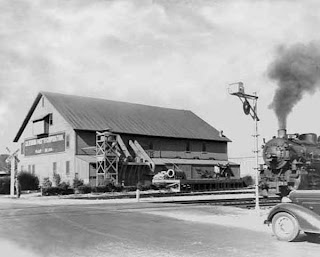As we all remember from previous discussions, the key design features of a dried fruit packing house (at least in turn-of-the-century California) was:
- build big and barn-like (because the packing house had to store the entire year's crop until it could be sold),
- three stories tall to hold the gravity-fed storage bins, and
- a (preferably non-carnivorous) powered elevator to get the crop up to the top floor for sorting and storage.
The Del Monte Building fits the model nicely. Built in 1904 and originally located at 185 Evelyn Ave. next to the railroad tracks, it was the sole Santa Clara Valley outpost of Madison and Bonner, a dried fruit packer with multiple plants out in the Fresno area. The plant's location hints that M&B was willing to take a big chance to branch out from the raisin market into the prune, peach, cherry, and apricot market of the Bay Area. In the typical breathless fashion of the news media at the time, the San Jose Herald (as quoted in the September 15, 1906 Pacific Rural Press) claims "Madison & Bonner have nearly completed enlarging the dried fruit packing house and are installing new machinery. This enterprise will be second to none in the county." As a San Jose booster, I seriously doubt that claim, but I'll assume they had a nice plant that might have hoped to be the equal of one of the San Jose and Campbell dried fruit packing houses some day. Maybe.
Madison and Bonner - James Madison and Charles G. Bonner, for there really were two flesh-and-blood men behind that title - only lasted to 1911 when the two principals decided to dissolve the company. Bonner took over the Fresno raisin plants, changed the signs to "Bonner Packing" and started billing the company in the trade rags as "successors to Madison and Bonner." The distant Sunnyvale plant went to J. K. Armsby, a large San Francisco-based packer. I don't know what Madison was left with, but I'm hoping he took off for Hawaii with the proceeds.
The J. K. Armsby company, then run by J.K.'s son, George Newell Armsby, had multiple plants around California and the West at the time of the purchase. In 1913, they listed their presence in Fresno, San Jose, Armona, Visalia, Sanger, Suisun, Marysville, Los Angeles, Gilroy, Yuba City, Stockton, Ventura, Sunnyvale, and even an outpost in Vancouver Washington. The 1916 list in an ad omits Sunnyvale, with no hint whether the plant was closed, or if the printer just ran out of room for another name.
But George wanted to run an even more massive organization, and in 1916, he headed east to New York, convinced a New York banker to lend him 16 million dollars, and headed back to purchase and merge five companies into his new California Packing Corporation, better known to us as Del Monte. Those five companies were:
- his own J. K. Armsby company, with local plants in Sunnyvale, Gilroy, and San Jose,
- Griffin and Skelley, who started out packing oranges in Riverside and moved on to raisins and prunes with a large plant in San Jose that became Del Monte #51,
- Central California Canneries in San Jose (the Japantown cannery), Tulare, and (I'm sure) other places,
- California Fruit Canners Association, itself a conglomerate merged from 18 canneries in 1899, including the San Francisco Plant #1 (the Cannery), the San Jose Fruit Packing Co. (which brought the large cannery on San Carlos St. in San Jose), Oakland Preserving Company, and others, and
- the Alaska Packers Association.
The Sunnyvale packing house served as a receiving station for Del Monte from 1916 to 1926. However, good roads and easy access to cars probably hinted to the bean counters at Del Monte that they didn't need as many receiving stations scattered over the countryside, and certainly didn't need the Sunnyvale location. The Planning Department for Sunnyvale says that Del Monte opened a new dried fruit packing house in San Jose in 1926 - Del Monte's Plant #51 on Bush St. just west of Diridon Station, and the former Griffin and Skelley plant. The new plant got rid of the need for the local receiving stations, and so the Sunnyvale receiving station was closed and mothballed as a warehouse.
Luckily, the Del Monte building got a second lease on life in 1930, turning into the Corporate Seed research lab for Del Monte. Del Monte only left it in 1986 - well after the rest of the valley had started growing silicon wafers instead of prunes. In 1993, it even lost its location next to the railroad tracks, but was moved onto the one block remnant of Sunnyvale's main shopping street, Murphy Ave, where it serves as the endcap for a small but fun downtown.
And with some luck, you might get invited to a wedding up on the third floor of the now-restored building, and you can think of all the prunes and apricots that got sorted up there when the decor was a trifle more rustic.
[Image of the Sunnyvale Del Monte building from Sunnyvale Historical Society. The building has its own web site for its banquet business.]




No comments:
Post a Comment
Note: Only a member of this blog may post a comment.